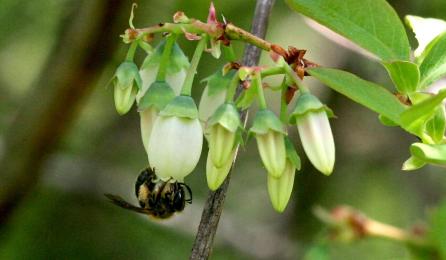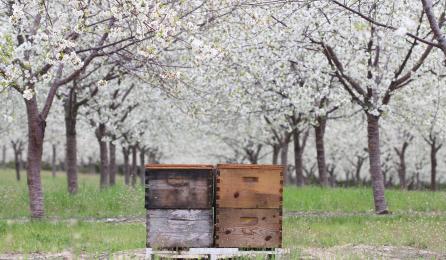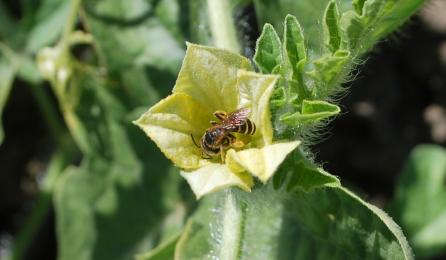
What is Integrated Crop Pollination?
Integrated crop pollination is the combined use of multiple pollinator species, habitat augmentation, and crop management practices to provide reliable and economical pollination of crops. Pollinator species can include managed honey bees, alternative managed bees, and many different types of wild bees. Habitat augmentation refers to adding floral and nesting resources to farms (e.g. wildflower strip, meadows, and hedgerows). Crop management practices that support pollination include modifying pest management practices to reduce risks to pollinators, using conservation tillage, and allowing cover crops to bloom. Reliable and economical pollination may come from honey bees alone or from a combination of different pollinators. It all depends on the crop, on the farm situation, and the economics of different approaches.
Factsheets on crop pollination for specialty crop growers
- 4 Ways to Help Bees Help You! (PDF)
- Almond Pollination (California) (PDF)
- Apple Pollination (Michigan) (PDF)
- Apple Pollination (Pennsylvania) (PDF)
- Blueberry Pollination (British Columbia) (PDF)
- Blueberry Pollination (Florida) (PDF)
- Blueberry Pollination (Michigan) (PDF)
- Blueberry Pollination (Vermont) (PDF)
- Cane Fruit Pollination (Oregon) (PDF)
- Cherry Pollination (Michigan) (PDF)
- Pumpkin Pollination (Pennsylvania) (PDF)
Resources for extension professionals
Researchers with the Integrated Crop Pollination Project surveyed specialty crop growers to determine pollination practices and grower perspectives on crop pollination. Access the regional and crop specific reports below.
- CA Almond Report (PDF)
- FL Blueberry Report (PDF)
- MI Blueberry Report (PDF)
Watch recorded webinars on the following topics:

Ensuring almond pollination
Presented by Theresa Pitts-Singer, USDA-ARS/Utah State University
 Pollinating highbush blueberries: bees bring bigger berries
Pollinating highbush blueberries: bees bring bigger berries
Presented by Rufus Isaacs, Michigan State University
 Pollinating apples and cherries East of the Rockies
Pollinating apples and cherries East of the Rockies
Presented by Julianna Wilson, Michigan State University
 On-farm pollinator benefits for watermelon pollination
On-farm pollinator benefits for watermelon pollination
Presented by Neal Williams, University of California, Davis
 Ensuring pumpkin pollination
Ensuring pumpkin pollination
Presented by Shelby Fleischer, Pennsylvania State University
 How to manage solitary orchard bees for crop pollination
How to manage solitary orchard bees for crop pollination
Presented by: Theresa Pitts-Singer, Utah State University
The Integrated Crop Pollination Project
Members of the Integrated Crop Pollination Project Team are investigating the performance, economics, and farmer perceptions of different pollination strategies in various fruit and vegetable crops. This project is supported by USDA-NIFA Specialty Crop Research Initiative Grant (#2012-51181-20105). To learn more go to the project website at projecticp.org or read the project brochure click here.
Project Objectives:
- Identify economically-valuable pollinators and the factors affecting their abundance.
- Develop habitat management practices to improve crop pollination.
- Determine performance of alternative managed bees as specialty crop pollinators.
- Demonstrate and deliver ICP practices for specialty crops.
- Determine optimal methods for ICP information delivery and measure ICP adoption.
- Economics and modeling of pollination ecosystem services.
Project Advisory Panel:
This project is advised by a diverse group of stakeholders with interest in crop pollination. The project’s advisory panel includes representatives from the organizations listed below.
- American Fruit Grower Magazine
- California Almond Board
- Cardno J.F. New
- Crown Bees
- MBG Marketing
- Orchard Bee Association
- Oregon State University Extension
- Peerbolt Crop Management
- University of Reading
- University of Minnesota
- USDA-Farm Service Agency
- USDA-Natural Resource Conservation Service
Project team contributing to materials on this page
- Rufus Isaacs, Michigan State University, East Lansing, MI
- Kelly Garbach, Point Blue Conservation Science, Petaluma, CA
- Eric Lonsdorf, University of Minnesota, Minneapolis, MN
- Keith Mason, Michigan State University, East Lansing, MI
- Theresa Pitts-Singer, USDA-ARS Pollinating Insects Research Unit, Logan, UT
- Taylor Ricketts, University of Vermont, Burlington, VT
- Mace Vaughan, The Xerces Society, Portland, OR
- Neal Williams, University of California – Davis, Davis, CA
- Derek Artz, USDA-ARS Pollinating Insects Research Unit, Logan, UT
- Mary Bammer, University of Florida, Gainesville, FL
- David Biddinger, Pennsylvania State University, University Park, PA
- Natalie Boyle, USDA ARS Pollinating Insects Research Unit, Logan, UT
- Claire Brittain, University of California – Davis, Davis, CA
- Josh Campbell, University of Florida, Gainesville, FL
- Jim Cane, USDA ARS Pollinating Insects Research Unit, Logan, UT
- Jaret Daniels, University of Florida, Gainesville, FL
- Elizabeth Elle, Simon Fraser University, Burnaby, British Columbia, CA
- Jamie Ellis, University of Florida, Gainesville, FL
- Shelby Fleischer, Pennsylvania State University, University Park, PA
- Jason Gibbs, Michigan State University, East Lansing, MI
- Bob Gillespie, Wenatchee Valley College, Wenatchee, WA
- Larry Gut, Michigan State University, East Lansing, MI
- George Hoffman, Oregon State University, Corvallis, OR
- Jennifer Hopwood, The Xerces Society, Portland, OR
- Neelendra Joshi, Pennsylvania State University, University Park, PA
- Karen Klonsky, University of California-Davis, Davis, CA
- Insu Koh, University of Vermont, Burlington, VT
- Claire Kremen, University of California-Berkeley, Berkeley, CA
- Emily May, The Xerces Society, New Haven, CT
- Sujaya Rao, Oregon State University, Corvallis, OR
- James Reilly, Rutgers University, New Brunswick, NJ
- Nikki Rothwell, Michigan State University, Traverse City, MI
- Cory Stanley-Stahr, University of Florida, Gainesville, FL
- James Strange, USDA-ARS Pollinating Insects Research Unit, Logan, UT
- Katharina Ullmann, The Xerces Society, Davis, CA
- Kimiora Ward, University of California – Davis, Davis, CA
- Julianna Wilson, Michigan State University, East Lansing, MI
- Rachael Winfree, Rutgers University, New Brunswick, NJ
Funding for the Integrated Crop Pollination Project was provided by USDA-NIFA Specialty Crop Research Initiative Grant (#2012-51181-20105).
